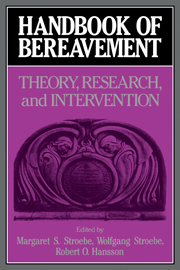Book contents
- Frontmatter
- Contents
- Contributors
- Preface
- Part I Introduction
- Part II The phenomenology and measurement of grief
- 2 The course of normal grief
- 3 Pathological grief reactions
- 4 Measurement issues in bereavement
- Part III Current theories of grief, mourning, and bereavement
- Part IV Physiological changes following bereavement
- Part V The psychological, social, and health impacts of conjugal bereavement
- Part VI Grief reactions to different types of loss
- Part VII Coping, counseling, and therapy
- Part VIII Conclusions
- References
- Author index
- Subject Index
3 - Pathological grief reactions
Published online by Cambridge University Press: 04 May 2010
- Frontmatter
- Contents
- Contributors
- Preface
- Part I Introduction
- Part II The phenomenology and measurement of grief
- 2 The course of normal grief
- 3 Pathological grief reactions
- 4 Measurement issues in bereavement
- Part III Current theories of grief, mourning, and bereavement
- Part IV Physiological changes following bereavement
- Part V The psychological, social, and health impacts of conjugal bereavement
- Part VI Grief reactions to different types of loss
- Part VII Coping, counseling, and therapy
- Part VIII Conclusions
- References
- Author index
- Subject Index
Summary
In many areas of medicine it is difficult to distinguish normal and abnormal, nonpathological and pathological, or health and disease. The study of bereavement shares this difficulty. This chapter focuses on major theoretical perspectives that might aid in defining or understanding pathological grief. A historical overview is provided, and questions are raised regarding the overlap between grief and defined disorder. In particular, discussion focuses on the problem that research to date has not clearly identified areas of psychopathology that are grief-specific. This reflects in part a lack of operationalized criteria for pathological grief.
Defining pathological grief
The field is still struggling to validate and operationalize the construct of “normal” grief (cf. Shuchter & Zisook, this volume). When the focus is then extended to include a range of “abnormal” forms of grief, the difficulties are compounded. Where grief for a particular individual, in a particular culture, appears to deviate from the expected course in such a way that it is associated with excessive or prolonged psychological or physical morbidity, it may be labeled as pathological. Such classification may be descriptive or it may imply a theoretical construct. Furthermore, often it is not clear as to whether the term grief is intended to pertain simply to the affective reaction to loss, as a commonly accepted meaning, or to refer to all aspects of the bereavement reaction and a range of other states.
- Type
- Chapter
- Information
- Handbook of BereavementTheory, Research, and Intervention, pp. 44 - 61Publisher: Cambridge University PressPrint publication year: 1993
- 52
- Cited by

